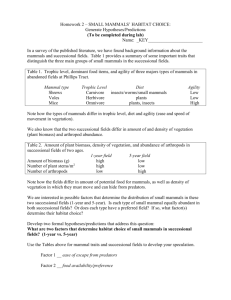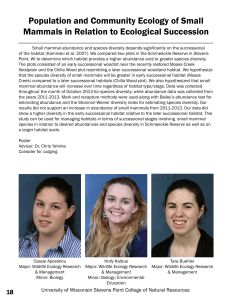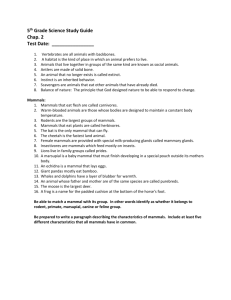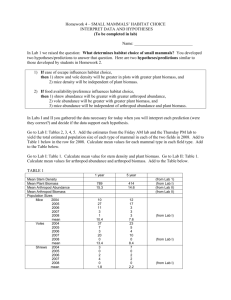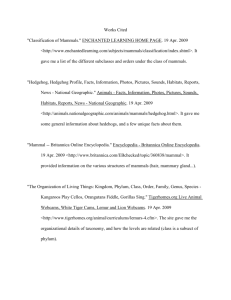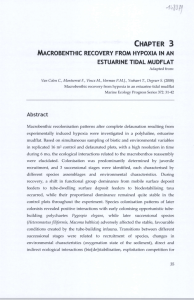Homework 2A – SMALL MAMMALS` HABITAT CHOICE:
advertisement
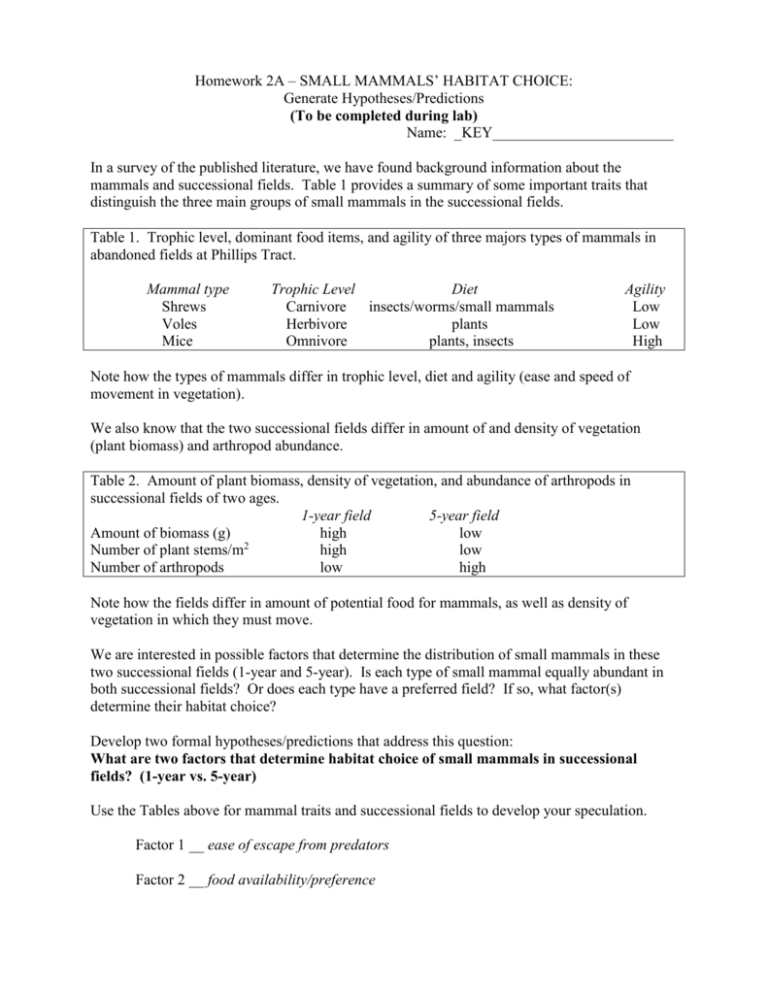
Homework 2A – SMALL MAMMALS’ HABITAT CHOICE: Generate Hypotheses/Predictions (To be completed during lab) Name: _KEY________________________ In a survey of the published literature, we have found background information about the mammals and successional fields. Table 1 provides a summary of some important traits that distinguish the three main groups of small mammals in the successional fields. Table 1. Trophic level, dominant food items, and agility of three majors types of mammals in abandoned fields at Phillips Tract. Mammal type Shrews Voles Mice Trophic Level Diet Carnivore insects/worms/small mammals Herbivore plants Omnivore plants, insects Agility Low Low High Note how the types of mammals differ in trophic level, diet and agility (ease and speed of movement in vegetation). We also know that the two successional fields differ in amount of and density of vegetation (plant biomass) and arthropod abundance. Table 2. Amount of plant biomass, density of vegetation, and abundance of arthropods in successional fields of two ages. 1-year field 5-year field Amount of biomass (g) high low Number of plant stems/m2 high low Number of arthropods low high Note how the fields differ in amount of potential food for mammals, as well as density of vegetation in which they must move. We are interested in possible factors that determine the distribution of small mammals in these two successional fields (1-year and 5-year). Is each type of small mammal equally abundant in both successional fields? Or does each type have a preferred field? If so, what factor(s) determine their habitat choice? Develop two formal hypotheses/predictions that address this question: What are two factors that determine habitat choice of small mammals in successional fields? (1-year vs. 5-year) Use the Tables above for mammal traits and successional fields to develop your speculation. Factor 1 __ ease of escape from predators Factor 2 __ food availability/preference Hypothesis/Prediction 1 Incorporate your first factor into a complete sentence that answers the question posed. Convert your sentence to a formal hypothesis: If ease of escape from predators determines habitat choice of small mammals, Now develop a prediction of the hypothesis. Consider what is a logical consequence of that hypothesis? If the hypothesis is correct, what would you predict about the distribution of the type of mammal in the two fields? (HINT: You may need to make a separate prediction for each mammal type). then 1) shrew and vole density will be greater in succesional area with greater plant biomass, 2) mice density will be independent of plant biomass. 1) Is the experimental design contained in the hypothesis or the prediction? I.e.,where are located your independent variable (something with a natural categorization) and dependent variable (operationally, what you will measure) in prediction 2) Is the independent variable continuous or categorical? categorical 3) How many treatments are in your experimental design? Two (yr 1 and yr 5) 4) What are you going to measure? (Circle the response dependent variable). Shrew and mole density Hypothesis/Prediction 2 If food availability/preference influences habitat choice, Then 1) shrew abundance will be greater with greater arthropod abundance, 2) vole abundance will be greater with greater plant biomass, and 3) mice abundance will be independent of arthropod abundance and plant biomass. What is the unit of measurement for your dependent (response) variable? One small mammal What represents one sampling unit? One successional field To do a statistical test to decide if your prediction is correct, it is desirable to get replicates of your sampling unit. Ideally you would gather data in multiple fields of each age. These repeated samples are called replicates. How many replicates of the sampling unit of each treatment would you plan to collect? Five??
